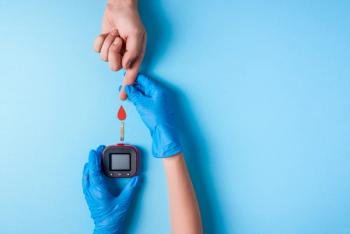
Flash Glucose Monitoring May Prompt Lifestyle Changes in Prediabetes
New research indicates that glucose monitoring could lead to lifestyle changes during prediabetes.
Use of flash glucose monitoring could promote lifestyle changes in people with diabetes, according to a new study.
A single-arm, prospective study conducted among people with prediabetes, results of the study demonstrate people with prediabetes using a flash glucose monitoring system felt use of the system would allow them to make lifestyle changes aimed at preventing progression to diabetes, with the majority of patients noting they would recommend use to other people with prediabetes.
“To the best of our knowledge, this is the first study that explored the feasibility and acceptability of wearing [flash glucose monitoring system] sensors among people with prediabetes,” wrote investigators. “While we confirmed that people with prediabetes were receptive to wearing [flash glucose monitoring system] sensors, our study endured a high uncontactable rate, which was likely due to recruiting participants from medically underserved communities and the impact of the COVID-19 pandemic.”
As continuous glucose monitoring (CGM) technology continues to advance at a rapid rate, improved systems have led to questions surrounding potential application in populations beyond those with a diagnosis of type 1 or type 2 diabetes, including in-hospital settings and, in the present study, people with prediabetes. With an interest in exploring use in those with prediabetes, the current endeavor was designed by investigators from the University of California, Irvine as a single-arm, prospective study with the specific intent of describing the feasibility and acceptability of flash glucose monitoring system sensors for empowering lifestyle changes in this patient population.
Recruiting patients receiving care within a pair of federally qualified health care centers, investigators invited patients to wear flash glucose monitoring sensors for 28 days. Investigators measured feasibility through subject recruitment, which was assessed via subject adherence rates and subject retention rates. For the purpose of analysis, acceptability was assessed via a semistructured, 1-on-1 interview, which consisted of an 11-item flash glucose monitoring system satisfaction scale and 4 open-ended questions on sensor-related preferences.
Overall, 136 subjects were referred to the study. Of these, 33.3% were uncontactable, 17.6% were undecided, 25.0% declined due to disinterest or lack of time, and 23.5% agreed to partake in the study. The 32-subject cohort included the study had a mean age of 52 years and a mean duration of prediabetes of 1.5 years. When asked to rate the importance of reversing prediabetes on a scale of 0-10, with 10 indicating very important, the mean score was 9.7.
During the 28-day period, all subjects were adherent to wearing the first followed by the second sensor. A total of 16 sensors fell off and required replacement, with the overall average days of sensor wear among participants at 25 days.
In regard to the open-ended questions, investigators pointed out a pair of themes that arose when questioning the “best thing” about wearing a sensor, which were “positive behavior change” and “improved understanding from real-time feedback”. When assessing the “worst thing” about wearing a sensor, “mechanics of the sensor” was the only theme identified by investigators.
Highlights of the 11-item satisfaction scale are listed below:
- 62.5% disagreed or strongly disagreed wearing sensors caused others to ask too many questions about health status.
- 75% disagreed or strongly disagreed wearing the sensor was uncomfortable or painful.
- 81.3% agreed or strongly agreed the sensor reminded them to stay healthy on a daily basis.
- 68.8% agreed or strongly agreed that they would pay a copay to use a flash glucose monitoring system sensor for people with prediabetes if it were covered by insurance.
- 78.1% agreed or strongly agreed they would want to use the device when the research study was over, if possible.
“Future studies should incorporate larger randomized controlled studies to better evaluate the advantages and disadvantages of incorporating [flash glucose monitoring system] sensors into the care of people with prediabetes,” investigators added.
Reference
1. Lee JY, Nguyen JT, Arroyo J, Tran T, Hanami D, Mayorga J. Feasibility and acceptability of using flash glucose monitoring system sensors to empower lifestyle changes in people with prediabetes. Diabetes Care. 2022 Nov 18;dc220612. doi: 10.2337/dc22-0612.
Newsletter
Pharmacy practice is always changing. Stay ahead of the curve with the Drug Topics newsletter and get the latest drug information, industry trends, and patient care tips.




